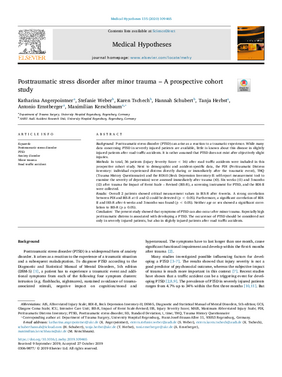Background:
Posttraumatic stress disorder (PTSD) can arise as a reaction to a traumatic experience. While many data concerning PTSD in severely injured patients are available, little is known about this disease in slightly injured patients after road traffic accidents. It is rather assumed that PTSD does not exist after objectively slight injuries.
Methods:
In total, 36 patients (Injury Severity Score < 16) after road traffic accidents were included in this prospective cohort study. Next to demographic and accident-specific data, the PDI (Peritraumatic Distress Inventory: individual experienced distress directly during or immediately after the traumatic event), THQ (Trauma History Questionnaire) and the BDI-II (Beck Depression Inventory-II: self-report measurement tool to examine the severity of depression) were assessed immediately after trauma (t0). Six weeks (t1) and 3 months (t2) after trauma the Impact of Event Scale – Revised (IES-R), a screening instrument for PTSD, and the BDI-II were collected.
Results:
Overall 2 patients showed critical measurement values in IES-R after 6 weeks. A strong correlation between PDI and IES-R at t1 and t2 could be detected (p < 0.05). Furthermore, a significant correlation of BDIII and IES-R after 6 weeks and 3 months was found (p < 0.05). Neither age or sex showed a significant correlation to IES-R (p≥0.05).
Conclusion:
The present study showed that symptoms of PTSD can also occur after minor trauma. Especially high peritraumatic distress is associated with developing a PTSD. The occurrence of PTSD should be considered not only in severely injured patients, but also in slightly injured patients after road traffic accidents.
